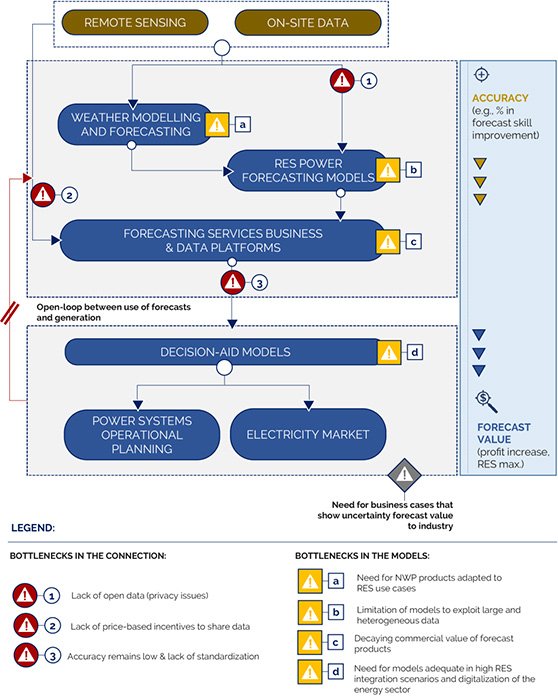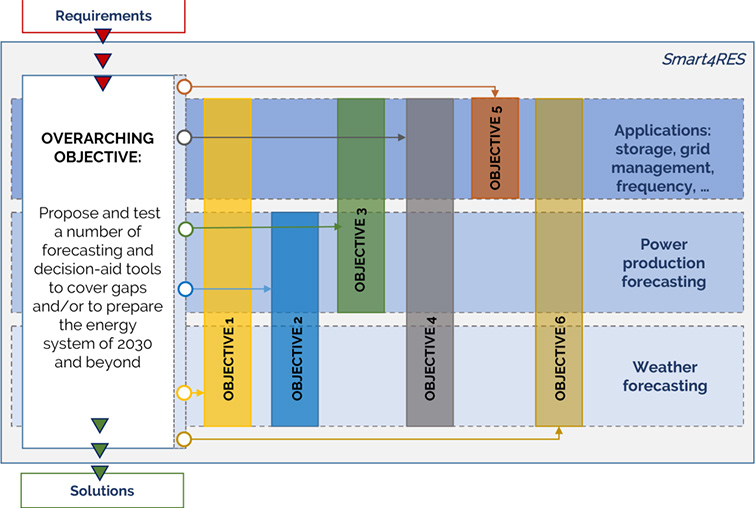Establish a new standard for the entire RES forecasting value chain
Context
European power systems are facing major changes as a result, among other factors, of the massive penetration of weather-dependent Renewable Energy Sources (RES) generation.
The continuously increasing share of RES in the electricity generation mix of several countries and the intermittent nature of RES generation brings several challenges to power system operation.
Short-term forecasting of RES generation, a few minutes up to days ahead is a key prerequisite for the secure and economic operation of power systems with high RES penetration.
The RES forecasting value chain integrates tools for weather forecasting, RES forecasting and models related to the applications the forecasts that are used for (i.e. decision making for trading). A series of gaps and bottlenecks limit the performance of this model chain, including the limitations of weather forecasting models, the necessity to connect RES forecasting with research in the field of meteorology, and the under-usage of the data being collected to improve RES forecasts

Project description
Project aim
Smart4RES aims to develop and validate the next generation tools that jointly enable:
• an increase of at least 15% in RES forecasting performance and,
• leverage the economic value of RES forecasting by considering the whole value chain from weather forecasting to end-use applications.
To achieve this vision, Smart4RES proposes disruptive research ideas with the objective to reach breakthrough rather than incremental improvements.
Vision
The digitalisation of the energy sector has generated a new landscape featuring the emergence of a wealth of data that were previously not available. The exploitation of these data (in combination with current computational and data storage capabilities), through new adapted modelling tools, is the key to change the game in RES forecasting but also for the decision-making tools that use these forecasts in end-use applications. The knowledge created will be the foundation for the next generation of modelling and short-term forecasting tools of weather-dependent RES power production and related decision making.
The expectations from such next generation tools include:
Outstanding level of accuracy to reduce the impacts of RES intermittency under large-scale integration in power systems and electricity markets.
Ability to maximise the value that the tools bring to applications where RES forecasts are used as input and mitigate risks associated with residual uncertainty.
Ability to exploit jointly existing and new sources of data (weather and RES power measurements, remote sensing, etc.) compared to current models, which have a high dependability on data sources.
Coverage of all weather-dependant renewable sources with the highest expected market share in the next decades (e.g. wind power, photovoltaic (PV), solar thermal, run-of-the-river hydro, combinations).
Ability to cover the full spectrum of temporal scales, i.e. very short term (minutes to next hours), short term (hourly to 2-3 days), longer term (up to 10 days and more), and spatial scales, i.e. RES plant level up to aggregations, regional or national. These expectations are accompanied by the ambition to have a major impact on the state of the art and to contribute to Europe’s international leadership in the field.

Objectives
The overarching goal of Smart4RES encompasses the research, development and validation of a next generation of tools for modelling and forecasting energy production from variable renewables and decision aid for a number of use cases. This goal is decomposed into six technical objectives
Objective 1
To define requirements for forecasting technologies to enable near 100% RES penetration by 2030 and beyond
Objective 2
To develop a RES-dedicated view of weather forecasting, leading to improvements in forecasting of the relevant weather variables in the order of 10-15% using various sources of data (satellite, all-sky imagers, NWPs), and the development of very high-resolution forecasting approaches
Objective 3
To develop a new generation of RES forecasting tools that are able to improve RES power production forecasting by at least 15%
Objective 4
To streamline the process of getting optimal value from data and forecasts, through new forecasting products and data marketplaces, and novel business models
Objective 5
To develop new data-driven optimisation and decision-aid tools for enabling the large-scale penetration of renewable energy, combined with storage, into the electricity market as well as to provide system services towards TSOs and DSOs
Objective 6
Validation of new models in living labs and assessment of forecasting value vs remedies
